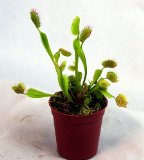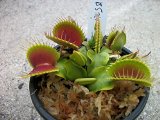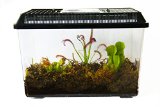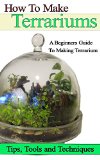- One important rule of thumb for this is to never ever feed your fly trap human food. And this includes hamburger. Do not feed your flytrap hamburger!
- If you can, catch some flies and feed them to the flytrap!
- You do have a pet store alternative. Most pet stores carry crickets because they are a standard food of many reptiles. What you can do is ask the pet store personnel to get you some baby crickets. They have to be baby ones that are as small as possible. These will work very well for your flytrap.
- Also, you shouldn't feed your flytrap more than once a week. This is the absolute maximum. It is a lot of fun to feed it but resist the temptation to feed it more often than that!
- And, you should resist the urge to stick something into the mouth of the flytrap just to see it trap close. This is a big strain on the plant.
- Do not feed your flytrap small caterpillars that are alive because they will eat their way right out!
Here are some great ideas submitted by a web visitor (FOGG)
1. Combine a VFT with an antfarm so food is always available.
2. Build a terrarium that contains a number of plants that certain local bugs eat. Let the plants get established.
3. Introduce the bugs and let them get established.
4. Introduce the VFT in a sandy mossy part of the terrarium so the bugs can find them and you should have a cycle that you only need a screen top on to keep the bugs in and to add a little water to.
Making A Venus Fly Trap Terrarium?
The Venus fly trap is one of the best selections for your first terrarium because it is hardy and easy to raise. It is also quite dramatic with jaws that close around its prey. Plant the fly traps in a terrarium that is made up of between 50 and 70 percent spaghnum moss or peat moss with the remainder either sand, perlite, or pumice. The Venus fly trap gains all its nutrients from the insects it eats so you should not use potting soil or any type of fertilizer. This would quickly kill the plants.
How to make your first carnivorous terrarium:
- Choose a dish or bowl for your terrarium
- Mix about half and half spaghnum or peat moss with sand, perlite or pumice
- Don't use potting soil
- Water with only distilled water - don't use tap water
- keep it well lit area or outside but not too much direct sunlight -Bright indirect sunlight is best
- They need high humidity so if you are in a dry climate you are going to have to put them in an enclosed terrarium with a dome top - I have some here
- Don't worry if toward autumn it seems to die back, this is normal; put it in the refrigerator for a couple of months (dormant period) it needs to hibernate like a bear does
- Don't activate the flytrap very often 5 or 6 times will kill it
- Do not feed it hamburger meat! Find small insects like baby crickets but not live caterpillars because they will eat their way out! Dead caterpillars, if they are small are ok.
The Venus fly trap needs lots of sunlight so it should be kept outdoors or in a well-lit location. It also has a dormant season where it will need to be kept cool for two to three months. In this time most of the foliage will die back, which is normal. If you live in a warm climate you can keep the plants in your refrigerator for the dormant season.
When watering your plants keep the soil moist and use only distilled water. The chemicals in tap water can kill the plants. And if you absolutely have to use tap water I recommend you let it sit for 48 hours before using. The fly trap has quite a tolerance for water and can actually survive for extended periods of time underwater. The rule of thumb is to keep the planting material moist but not soggy.
Caring for the plants is easy but there are a couple of rules you should adhere to. Do not excessively spring the fly traps shut. This is how they eat and they need to be open. Repeated use can also cause the traps to not function well. (It will only work five or six times then it will stop and the trap will die off). And you should never feed your plants ground hamburger. This is unhealthy for them and may kill them. Their metabolism is tuned to eating small insects not cows! If you keep your plants in an enclosed terrarium you will have to hand feed them yourself and a good source of food for them is small crickets, which can be bought at any well-stocked pet store.
If you are looking for a carnivorous plant that is easier to care for and doesn’t have to go through a dormancy period you might want to consider getting the Cape Sundew. This is a tropical plant that has the same trap door like action as the fly trap. Its motion is however, much slower. It takes about fifteen minutes for the trap to fully close. And although it is not as dramatic as the Venus fly trap it is much easier to care for.
Carnivorous plants have a very particular allure because they are evolved such an unusual mechanism for survival. By knowing and following these few simple rules you can use them in a terrarium that will bring you lots of enjoyment for years to come.
 
Large Venus Fly Trap Plant
- Large Venus Fly Trap is growing in a 4 inch pot, similar to the pictures
- Keep moist at all times; rainwater or distilled water are preferred
- The insects it catches provide natural nourishment
- Select a sunny window for your Venus Flytrap
- Nature provides this remarkable plant with "traps" to lure and capture its food

Medium Sized B52 Giant Venus Flytrap - 3 Inch Pot
- Live healthy Medium Sized B52 Giant Venus Flytrap Plant (This is larger than medium size for a typical Venus Flytrap)
- Comes with a 3 inch net pot
- Comes with a detailed full page caresheet, full page FAQ sheet, and a full page potting diagram
- Shipped bareroot
- Comes with loose moss appropriate for Carnivorous Plant soil

3 Live Adult Carnivorous Plants in Deluxe Terrarium: Venus Fly Trap, Pitcher Plant, Sundew
- This deluxe terrarium has healthy LIVE ADULT Carnivorous Plants, ready to chomp some bugs!
- Nice sized 2 to 3 inch adult plants. Venus flytraps will have at least 3 traps, pitcher plants at least 2 pitchers, sundews at least 6 leaves.
- Watch these fascinating plants grow in the included peat planting mix and large 2 gallon size planter terrarium with clear sides.
- This rare and unusual collection of carnivorous plants will flourish for years in this specially designed 11.75"L x 6.75"W x 8"H terrarium with proper care. Top picture on left is actual 3 month old terrarium in our office kept by people with no green thumb. Lids may be black, blue or green.
- GUARANTEED! We guarantee LIVE arrival of your plants. ****DO NOT ORDER if below 40 degrees or above 85 degrees in your area. Our live arrival guaranty will be void if ordered during these temperatures. YOU ARE RESPONSIBLE FOR CHECKING TEMPERATURES IN YOUR AREA to be sure your plants arrive alive.**** We ship this item via USPS (post office) within 4 business days.

Hungry Plants
This book offers readers a bug's-eye view into the strange and fascinating world of carnivorous plants. From the "jaws" of the Venus flytrap to the pretty sundew plant whose delicate tentacles entrap its prey, the unique anatomy and behaviors of meat-eating plants are detailed with clear, engaging text and art.
|
![]()








